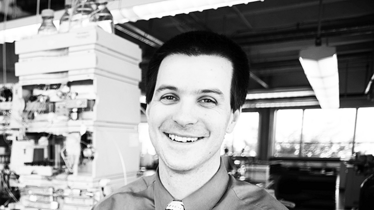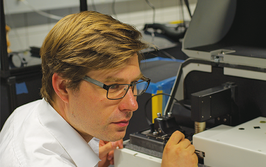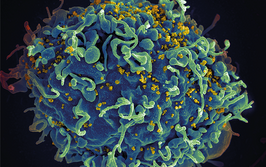Demystifying Two-Dimensional Liquid Chromatography
Dwight Stoll has been working in 2D-LC since 2000. Here, he talks about the benefits of what is a core technology in his research.
sponsored by Agilent Technologies
2D-LC and Me

How did you get into 2D-LC and why?
In 2000, I was working with Peter Carr who had been doing a lot of work on increasing the speed of HPLC separations. We decided to apply our expertise in performing fast separations to the second dimension; instead of 5–10 hour run times, we were aiming for 30 minutes without losing performance.
How was 2D-LC back then?
Pretty much everyone was making their own systems and writing their own software. Historically, the availability of robust 2D-LC systems has been a huge barrier – but that barrier is being torn down with a growing number of “off-the-shelf” solutions. That will undoubtedly change the perception and use of this powerful technique.
What are the main main benefits?
- The brute force of the 2D-LC technique in terms of separation power and the information that can be produced.
- The increased confidence in data in terms of hidden peaks – that’s why heart-cutting 2D-LC is rapidly becoming more popular.
- The potential for throughput gains, for example, by taking a 30 min 1D separation, compressing it to 10 min, and regaining lost resolution by bolting on a second dimension.
The final point is one that I’m very interested in. And while converting existing methods may seem irksome (every separation is different, after all), the potential in future method development is very clear. Instead of being satisfied with 30 min 1D runs, method development could be approached by starting with an end point in mind and pouring in separation power to gain the best efficiency.
Isn’t 2D-LC difficult?
Actually, even before commercial instruments became available, 2D-LC wasn’t exactly difficult, but it did take time and a certain amount of expertise and experience to know how to get the best out of it. Separation scientists in pharma and other big industries don’t have time to “play around”.
Much of our focus is on comprehensive 2D-LC where you’re trying to get a global profile of what’s in your sample. Heart-cutting separation work has been easier to do for a while, but there does seem to be a renaissance of late – the pharma industry is picking it up pretty quickly. Invariably, as big vendors offer the technology, it opens it up to a whole new segment of the community.
What advances facilitated “easy 2D-LC”?
The inability to do really fast gradient elutions in the second dimension was one big challenge in the past, but advances in pump technology have taken us down from gradient delay volumes of 1 ml to 100 µl. That was a big milestone. The development time that has been put into the software has also dramatically improved the user experience.
At what point does 2D-LC become the go to technique?
Ten years ago, it was clear to me (and everyone else) that 2D-LC was complicated enough that if its performance wasn’t clearly superior to the 1D case, the effort could not be justified. What we now know through simulations and experiments is that the “crossover time” – that is, the separation runtime at which 2D becomes superior to 1D – is about 10-15 minutes (1). That provided us with great motivation to stick with it; there are so many potential applications where you can clearly get a far superior separation in the same runtime.
Are we at a tipping point for 2D-LC adoption?
Increasing awareness, availability of vendor solutions and an evolving recognition that we’re at the wall with 1D are all coming together to make 2D that much more attractive. I recently had an email from a big pharma company saying, “We know we need more than 1D – please help us!” Put another way, when Genentech (for example) is able to contact Agilent (for example) with a 2D-LC part number, you know the landscape has changed dramatically!
Where do you foresee the biggest uptake?
Well, there are a number of groups in the polymer analysis community that have been using 2D-LC for a relatively long time and doing a lot of good work. They certainly deserve credit for their efforts in the field – presumably that will continue.
I think from now on, the biopharmaceutical industry is likely to make the biggest splash in terms of uptake because they have the most to gain. It’s also a relatively easy place to start as they can benefit from lessons learned in proteomics, where the first separation is performed with ion exchange and the second with reversed phase. That’s a really nice combination. The rumblings I’ve heard is that it is taking off like a rocket.
Dwight Stoll is assistant professor of analytical chemistry at Gustavus Adolphus College, MN, USA.
Reference
1. D. R. Stoll, X. Wang, and P. W. Carr, “Comparison of the Practical Resolving Power of One- and Two-Dimensional High-Performance Liquid Chromatography Analysis of Metabolomic Samples”, Anal. Chem. 80, 268–278 (2008).

Rich Whitworth completed his studies in medical biochemistry at the University of Leicester, UK, in 1998. To cut a long story short, he escaped to Tokyo to spend five years working for the largest English language publisher in Japan. "Carving out a career in the megalopolis that is Tokyo changed my outlook forever. When seeing life through such a kaleidoscopic lens, it's hard not to get truly caught up in the moment." On returning to the UK, after a few false starts with grey, corporate publishers, Rich was snapped up by Texere Publishing, where he spearheaded the editorial development of The Analytical Scientist. "I feel honored to be part of the close-knit team that forged The Analytical Scientist – we've created a very fresh and forward-thinking publication." Rich is now also Content Director of Texere Publishing, the company behind The Analytical Scientist.

















